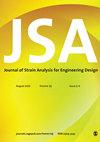OFHC铜管高应变成形的炸药类型研究
IF 1.8
4区 工程技术
Q3 ENGINEERING, MECHANICAL
Journal of Strain Analysis for Engineering Design
Pub Date : 2021-05-26
DOI:10.1177/03093247211021240
引用次数: 3
摘要
本文对五种不同炸药作用下无氧高导热铜管的爆炸成形进行了计算研究。为了研究炸药种类对OFHC铜管成形性的影响,采用有限元法比较了常用炸药C-4、TNT、HMX、Comp-B和PBXN。为了验证所建立的有限元模型,采用C-4进行了爆炸成形实验。在模拟中,采用耦合欧拉-拉格朗日(CEL)方法模拟大变形,Jones-Wilkins-Lee (JWL)状态方程(EOS)定义爆炸特性,Johnson-Cook (J-C)强度和损伤模型描述金属的力学行为。利用Charpy冲击试验结果计算Hillerborg断裂能,并将其作为有限元输入。考虑啮合密度和摩擦系数,将有限元计算结果与爆炸成形试验结果进行了比较和验证。模拟结果表明,爆炸类型对铜管的最终形状和应变速率都有影响。以C-4的模拟结果为参照,HMX和PBX-N的应变率提高幅度大致为110%。而Comp-B和TNT分别降低了近10%和22%的应变速率。同时,爆炸类型改变了金属的最终硬度。用TNT进行模拟时,OFHC铜的硬度最低,为112.7 HV。采用HMX合金时,合金硬度最高,达到129.5 HV。此外,模拟还提出了希勒堡断裂能准则可用于爆炸模拟中对金属损伤的预测。本文章由计算机程序翻译,如有差异,请以英文原文为准。
Investigation of the explosive type on the high strain forming of OFHC copper tube
The paper computationally investigates the explosive forming of the oxygen-free high thermal conductivity (OFHC) copper tube subjected to five different explosives. To investigate the effect of explosive type on the formability of OFHC copper tube, commonly used explosives, including C-4, TNT, HMX, Comp-B, and PBXN, was compared by using the finite element method. To verify the developed finite element model (FEM), the explosive forming experiments were carried out by using C-4. In the simulations, Coupled-Eulerian-Lagrangian (CEL) method to model the large deformations, Jones-Wilkins-Lee (JWL) equations of state (EOS) to define the explosive properties and Johnson-Cook (J-C) strength and damage models to specify the metal’s mechanical behavior were utilized. Besides, Hillerborg’s fracture energy was calculated with the Charpy impact test results and given as input to the FEM. The results of FEM were compared and verified using the results of explosive forming tests considering the mesh density and friction coefficient. The simulations revealed that the explosive type affected both the final shape and also the strain rate of the copper tube. When the simulation results for C-4 was taken as reference, HMX and PBX-N increased the strain rate as 110%, roughly. However, Comp-B and TNT reduced the strain rate by nearly 10% and 22%, respectively. Also, the explosive type changed the final hardness of the metal. OFHC Copper had the lowest hardness (112.7 HV) when the simulations were conducted with TNT. In contrast, the highest hardness value (129.5 HV) was reached when HMX was used in the simulations. In addition, simulations put forth that Hillerborg’s fracture energy criteria could be used in the explosive simulations to predict the damage on the metals.
求助全文
通过发布文献求助,成功后即可免费获取论文全文。
去求助
来源期刊

Journal of Strain Analysis for Engineering Design
工程技术-材料科学:表征与测试
CiteScore
3.50
自引率
6.20%
发文量
25
审稿时长
>12 weeks
期刊介绍:
The Journal of Strain Analysis for Engineering Design provides a forum for work relating to the measurement and analysis of strain that is appropriate to engineering design and practice.
"Since launching in 1965, The Journal of Strain Analysis has been a collegiate effort, dedicated to providing exemplary service to our authors. We welcome contributions related to analytical, experimental, and numerical techniques for the analysis and/or measurement of stress and/or strain, or studies of relevant material properties and failure modes. Our international Editorial Board contains experts in all of these fields and is keen to encourage papers on novel techniques and innovative applications." Professor Eann Patterson - University of Liverpool, UK
This journal is a member of the Committee on Publication Ethics (COPE).
 求助内容:
求助内容: 应助结果提醒方式:
应助结果提醒方式:


